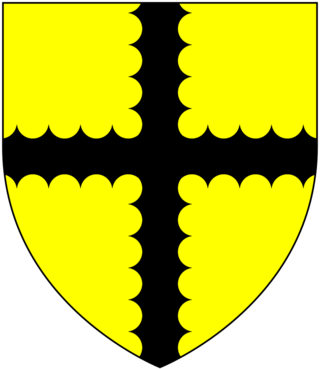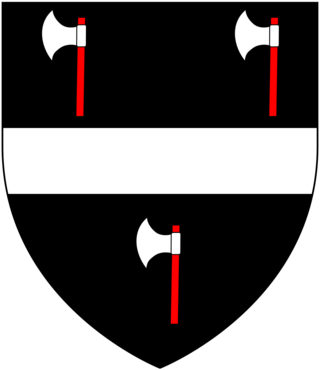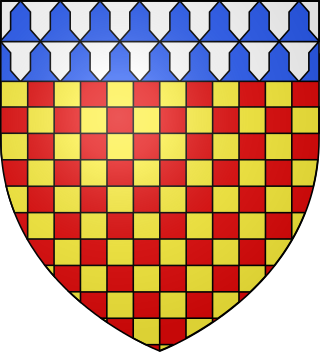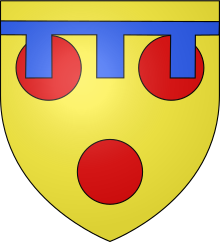Boconnoc is a civil parish in Cornwall, England, United Kingdom, approximately four miles (6 km) east of the town of Lostwithiel. According to the 2011 census the parish had a population of 96.

Sir Hugh de Courtenay, 2nd/10th Earl of Devon, 2nd Baron Courtenay, feudal baron of Okehampton and feudal baron of Plympton, played an important role in the Hundred Years War in the service of King Edward III. His chief seats were Tiverton Castle and Okehampton Castle in Devon. The ordinal number given to the early Courtenay Earls of Devon depends on whether the earldom is deemed a new creation by the letters patent granted 22 February 1334/5 or whether it is deemed a restitution of the old dignity of the de Redvers family. Authorities differ in their opinions, and thus alternative ordinal numbers exist, given here.

Humphrey Arundell of Helland in Cornwall, was the leader of Cornish forces in the Prayer Book Rebellion early in the reign of King Edward VI. He was executed at Tyburn, London after the rebellion had been defeated.

Sir Richard Edgcumbe of Cotehele in the parish of Calstock in Cornwall, was an English courtier and Member of Parliament.

Sir Philip Courtenay of Powderham, Devon, was the senior member of a junior branch of the powerful Courtenay family, Earls of Devon.

Sir William Courtenay (1451–1512) of Powderham in Devon, was a Lancastrian loyal to Henry Tudor, the future King Henry VII.

Francis Courtenay, de jure 4th Earl of Devon, of Powderham, Devon, was an English Member of Parliament. In 1831 he was recognised retrospectively as having been de jure 4th Earl of Devon, having succeeded his father in 1630.

Sir John Fowell, 3rd Baronet of Fowelscombe in the parish of Ugborough in Devon, was an English politician who sat in the House of Commons from 1689 to 1692.

Sir Reginald Mohun, 1st Baronet of Boconnoc in Cornwall, was a prominent member of the gentry of Cornwall and an MP.

.

Sir Peter Prideaux, 3rd Baronet (1626–1705), of Netherton in the parish of Farway, near Honiton, Devon, was an English politician.
Lieutenant-Colonel John Lambrick Vivian (1830–1896), Inspector of Militia and Her Majesty's Superintendent of Police and Police Magistrate for St Kitts, West Indies, was an English genealogist and historian. He edited editions of the Heraldic Visitations of Devon and of Cornwall, standard reference works for historians of these two counties. Both contain an extensive pedigree of the Vivian family of Devon and Cornwall, produced largely by his own researches.

Sir William Wrey, 1st Baronet of Trebeigh, St Ive, Cornwall and North Russell, Sourton, Devon, was High Sheriff of Cornwall in 1598 and was created a baronet by King Charles I in 1628.

Sir William Wrey, 2nd Baronet of Trebeigh, St Ive, Cornwall and North Russell, Sourton, Devon, was MP for Liskeard, Cornwall in 1624.

Robert Incledon (1676–1758) of Pilton House, Pilton, near Barnstaple in North Devon, was a lawyer of New Inn, London, a Clerk of the Peace for Devon, Deputy Recorder of Barnstaple and was twice Mayor of Barnstaple, in 1712 and 1721. In 1713 as mayor he supervised the building of the Mercantile Exchange on Barnstaple Quay, as recorded on the building by a contemporary brass plaque and sculpture of his armorials. He built Pilton House in 1746.

Philip Cary was an English landowner and politician from Devon.

Sir Peter Courtenay of Ugbrooke in the parish of Chudleigh, Devon, was Sheriff of Devon in 1548/9.

Sir John Chichester lord of the manor of Raleigh in the parish of Pilton, near Barnstaple, North Devon, was Sheriff of Devon in 1576/7 and/or in 1585 and died of gaol fever contracted whilst acting as a magistrate at the Lent Black Assizes of Exeter in 1586.

Wortham is an historic manor within the parish of Lifton in Devon, England. The early sixteenth century manor house survives, today the property of the Landmark Trust. It was long the seat of the Dynham family, a junior branch descended from the Anglo-Norman magnate Baron Dynham. A mural monument survives in Lifton Church to John Dynham (d.1641) of Wortham, consisting of an escutcheon showing the arms of Dynham of Wortham impaling Harris of Hayne ) with the crest of Dynham above: An arm couped or hand azure holding a lock of hair sable, with an inscribed tablet beneath. John Dynham (d.1641) was the last in the male line and married Margaret Harris (d.1650), a daughter of Arthur Harris (1561-1628) of Hayne in the parish of Stowford and lord of the manor of Lifton, both in Devon, and of Kenegie in the parish of Gulval in Cornwall, Sheriff of Cornwall in 1603 and Captain of St Michael's Mount, Cornwall. Arthur Harris's grandfather John Harris (d.1551) of Hayne, a Serjeant-at-Law and Recorder of Exeter, had purchased the manor of Lifton from the Nevile family, Earls of Northumberland. John Dynham (d.1641) died without children whereupon his heir was his niece Mary Hex, a daughter of his sister Margaret Dynham by her husband John Hex of Alternon in Cornwall, who married John Harris of Lifton, consequently Wortham passed to the Harris family.
A customer or custumer is an archaic term for a government appointed official who is empowered to collect taxation in the form of customs duty in certain defined physical locations or jurisdictions.















